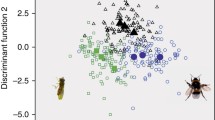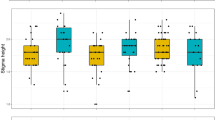Abstract
Spatial segregation of the sexes (SSS) has been reported in >30 dioecious species from 24 plant families. Such convergent evolution can arise via shared constraints and/or shared selective pressures but the extent to which SSS is adaptive is unresolved. In particular, because mating in plants occurs primarily among near neighbors, any fitness benefits of SSS should usually be offset by the separation of mating partners during reproduction. It has been argued that the problem of mating in plants with SSS should be alleviated in plants with more reliable modes of pollination, such as wind pollination. Accordingly, we evaluated the association between SSS and pollination mode using phylogenetically controlled comparative analyses. Moreover, because outcrossing plants produce many more pollen grains than ovules, females should compete less intensely for mating partners than males. We therefore predicted that any fitness costs arising from segregation should be greater for males than females. We evaluated this prediction using spatially explicit stochastic simulations. The comparative analyses indicated that there is indeed a positive association between wind pollination and SSS, but also that SSS might be associated with clonal growth. Because methods used for detecting SSS can be biased by clonality, this raises the possibility that some cases of SSS are ‘false positives’. The simulation results supported the prediction that male fitness is more strongly affected by segregation than female fitness. Contrary to arguments based on anecdotal evidence, increasing the effectiveness of pollen dispersal had little effect on the fitness of segregated males. Instead, our results indicated that the evolutionary maintenance of SSS requires substantial performance advantages to segregated males. However, there is little empirical evidence that such performance advantages exist. Future efforts to understand the evolution of SSS should focus on the detection of performance differences between segregated and unsegregated plants, particularly males.



Similar content being viewed by others
References
Albaladejo RG, Gonzalez-Martinez SC, Heuertz M, Vendramin GG, Aparicio AB (2009) Spatiotemporal mating pattern variation in a wind-pollinated Mediterranean shrub. Mol Ecol 18:5195–5206
Arbuckle K, Brockhurst M, Speed MP (2013) Does chemical defence increase niche space? A phylogenetic comparative analysis of the Musteloidea. Evol Ecol 27:863–881
Austerlitz F, Dick CW, Dutech C, Klein EK, Oddou-Muratorio S, Smouse PE, Sork VL (2004) Using genetic markers to estimate the pollen dispersal curve. Mol Ecol 13:937–954
Barrett SCH, Hough J (2013) Sexual dimorphism in flowering plants. J Exp Bot 64:67–68
Barrett SCH, Thomson JD (1982) Spatial pattern, floral sex ratios, and fecundity in dioecious Aralia nudicaulis (Araliaceae). Can J Bot 60:1662–1670
Bateman AJ (1948) Intra-sexual selection in Drosophila. Heredity 2:349–368
Bierzychudek P, Eckhart V (1988) Spatial segregation of the sexes of dioecious plants. Am Nat 132:34–43
Bond WJ, Midgley J (1988) Allometry and sexual differences in leaf size. Am Nat 131:901–910
Burczyk JL, Prat D (1997) Male reproductive success in Pseudotsuga menziesii (Mirb.) Franco: the effects of spatial structure and flowering characteristics. Heredity 79:638–647
Charlesworth D (2002) Plant sex determination and sex chromosomes. Heredity 88:94–101
Dawson TE, Bliss L (1989) Patterns of water use and the tissue water relations in the dioecious shrub, Salix arctica: the physiological basis for habitat partitioning between the sexes. Oecologia 79:332–343
Dawson TE, Ehleringer JR (1993) Gender-specific physiology, carbon isotope discrimination, and habitat distribution in Boxelder, Acer negundo. Ecology 74:789–815
Dawson TE, Geber MA (1999) Sexual dimorphism in physiology and morphology. In: Geber MA, Dawson TE, Delph LF (eds) Gender and sexual dimorphism in flowering plants. Springer, Berlin, pp 175–215
de Lucas A, Robledo-Arnuncio JJ, Hidalgo E, González-Martínez SC (2008) Mating system and pollen gene flow in Mediterranean maritime pine. Heredity 100:390–399
Delph LF (1999) Sexual dimorphism in life history. In: Geber MA, Dawson TE, Delph LF (eds) Gender and sexual dimorphism in flowering plants. Springer, Berlin, pp 149–173
Delph LF, Gehring JL, Arntz AM, Frey FM (2005) Genetic correlations with floral display lead to sexual dimorphism in the cost of reproduction. Am Nat 166:S31–S41
Dudley LS (2006) Ecological correlates of secondary sexual dimorphism in Salix glauca (Salicaceae). Am J Bot 93:1775–1783
Eppley SM (2001) Gender-specific selection during early life history stages in the dioecious grass Distichlis spicata. Ecology 82:2022–2031
Eppley SM (2005) Spatial segregation of the sexes and nutrients affect reproductive success in a dioecious wind-pollinated grass. Plant Ecol 181:179–190
Eppley SM, Pannell JR (2007) Density-dependent self-fertilization and male versus hermaphrodite siring success in an androdioecious plant. Evolution 61:2349–2359
Eppley SM, Stanton ML, Grosberg RK (1998) Intrapopulation sex ratio variation in the salt grass Distichlis spicata. Am Nat 152:659–670
Freckleton RP (2009) The seven deadly sins of comparative analysis. J Evol Biol 22:1367–1375
Freckleton RP, Harvey PH, Pagel M (2002) Phylogenetic analysis and comparative data: a test and review of evidence. Am Nat 160:712–726
Freeman DC, Kilkoff LG, Harper KT (1976) Differential resource utilization by the sexes of dioecious plants. Science 193:597–599
Freeman DC, Harper KT, Charnov EL (1980) Sex change in plants: old and new observations and new hypotheses. Oecologia 47:222–232
Freeman DC, Lovett-Doust J, El-Keblawy A, Miglia KJ, Durant-McArthur E (1997) Sexual specialization and inbreeding avoidance in the evolution of dioecy. Bot Rev 63:65–92
Friedman J, Barrett SCH (2009) Winds of change: new insights on the ecology and evolution of pollination and mating in wind-pollinated plants. Ann Bot 103:1515–1527
Hamilton WD (1967) Extraordinary sex ratios. Science 156:477–488
Harris MS, Pannell JR (2008) Roots, shoots and reproduction: sexual dimorphism in size and costs of reproductive allocation in an annual herb. Proc R Soc B 275:2595–2602
Harris MS, Pannell JR (2010) Canopy seed storage is associated with sexual dimorphism in the woody dioecious genus Leucadendron. J Ecol 98:509–515
Heilbuth JC, Ilves KL, Otto SP (2001) The consequences of dioecy for seed dispersal: modeling the seed-shadow handicap. Evolution 55:880–888
Hesse E, Pannell JR (2011) Density-dependent pollen limitation and reproductive assurance in a wind-pollinated herb with contrasting sexual systems. J Ecol 99:1531–1539
Korpelainen H (1991) Sex ratio variation and spatial segregation of the sexes in populations of Rumex acetosa and R. acetosella (Polygonaceae). Plant Syst Evol 174:183–195
Leigh A, Cosgrove MJ, Nicotra AB (2006) Reproductive allocation in a gender dimorphic shrub: anomalous female investment in Gynatrix pulchella? J Ecol 94:1261–1271
Levin DA, Kerster HW (1974) Gene flow in seed plants. Evol Biol 7:139–220
Lloyd DG (1974) Theoretical sex ratios of dioecious and gynodioecious angiosperms. Heredity 32:11–34
Lloyd DG (1984) Gender allocations in outcrossing cosexual plants. In: Dirzo R, Sarukhan J (eds) Perspectives on plant population ecology. Sinauer, Sunderland, pp 277–300
Lloyd DG, Bawa KS (1984) Modification of the gender of seed plants in varying conditions. Evol Biol 17:255–338
Maddison WP, Maddison DR (2011) Mesquite: a modular system for evolutionary analysis. Version 2.75. http://mesquiteproject.org
Melampy MN (1981) Sex-linked niche differentiation in two species of Thalictrum. Am Midl Nat 106:325–334
Mercer CA, Eppley SM (2010) Inter-sexual competition in a dioecious grass. Oecologia 164:657–664
Obeso JR (2002) The costs of reproduction in plants. New Phytol 155:321–348
Pagel M (1994) Detecting correlated evolution on phylogenies: a general method for the comparative analysis of discrete characters. Proc R Soc B 255:37–45
Pagel M (1999) Inferring the historical patterns of biological evolution. Nature 401:877–884
Pagel M, Meade A (2006) Bayesian analysis of correlated evolution of discrete characters by Reversible-Jump Markov Chain Monte Carlo. Am Nat 167:808–825
R Core Team (2013) R: a language and environment for statistical computing. R Foundation for Statistical Computing, Vienna, Austria. http://www.R-project.org/
Rogers SR, Eppley SM (2012) Testing the interaction between inter-sexual competition and phosphorus availability in a dioecious grass. Botany 90:704–710
Rognli OA, Nilsson NO, Nurminiemi M (2000) Effects of distance and pollen competition on gene flow in the wind-pollinated grass Festuca pratensis Huds. Heredity 85:550–560
Sakai AK, Weller SG (1999) Gender and sexual dimorphism in flowering plants: a review of terminology, biogeographic patterns, ecological correlates, and phylogenetic approaches. In: Geber MA, Dawson TE, Delph LF (eds) Gender and sexual dimorphism in flowering plants. Springer, Berlin, pp 1–31
Sanchez-Vilas J, Bermúdez R, Retuerto R (2012) Soil water content and patterns of allocation to below- and above-ground biomass in the sexes of the subdioecious plant Honckenya peploides. Ann Bot 110:839–848
Shea MM, Dixon PM, Sharitz RR (1993) Size differences, sex ratio, and spatial distribution of male and female water tupelo, Nyssa aquatic (Nyssaceae). Am J Bot 80:26–30
Smith SA, Beaulieu JM (2009) Life history influences rates of climatic niche evolution in flowering plants. Proc R Soc B 276:4345–4352
Sork VL, Davis FW, Smouse PE, Apsit VJ, Dye RJ, Fernandez-M JF, Kuhn B (2002) Pollen movement in declining populations of California Valley oak, Quercus lobata: where have all the fathers gone? Mol Ecol 11:1657–1668
Steven JC, Waller DM (2007) Isolation affects reproductive success in low-density but not high-density populations of two wind-pollinated Thalictrum species. Plant Ecol 190:131–141
Stevens PF (2001) Angiosperm phylogeny website. Version 12, July 2012
Van Drunen WE, Dorken ME (2012a) Trade-offs between clonal and sexual reproduction in Sagittaria latifolia (Alismataceae) scale up to affect the fitness of entire clones. New Phytol 196:606–616
Van Drunen WE, Dorken ME (2012b) Sex-ratio variation verses interplant distances in the regulation of pollen deposition and seed production in dioecious Cirsium arvense (Asteraceae). Botany 90:565–573
Vekemans X, Hardy OJ (2004) New insights from fine-scale spatial genetic structure analyses in plant populations. Mol Ecol 13:921–935
Webb CO, Donoghue MJ (2005) Phylomatic: tree assembly for applied phylogenetics. Mol Ecol Notes 5:181–183
Webb CO, Ackerly DD, Kembel SW (2008) Phylocom: software for the analysis of phylogenetic community structure and trait evolution. Bioinform Appl Note 24:2098–2100
Wikström N, Savolainen V, Chase MW (2001) Evolution of the angiosperms, calibrating the family tree. Proc R Soc B 268:2211–2220
Wright VL, Dorken ME (2014) Sexual dimorphism in leaf nitrogen content but not photosynthetic rates in Sagittaria latifolia (Alismataceae). Botany 92:109–112
Acknowledgments
We thank Maurine Neiman (via Axios Review), Mario Vallejo-Marín and four anonymous reviewers for helpful comments on an earlier version of the manuscript. We also thank the Natural Sciences and Engineering Research Council of Canada (NSERC) for supporting this work via a Canada Graduate Scholarship to W.E.V.D. and a Discovery Grant to M.E.D., and a Humboldt Research Fellowship for Experienced Researchers to M.E.D. for supporting a research leave at the University of Konstanz.
Author information
Authors and Affiliations
Corresponding author
Electronic supplementary material
Below is the link to the electronic supplementary material.
Rights and permissions
About this article
Cite this article
Van Drunen, W.E., Dorken, M.E. Wind pollination, clonality, and the evolutionary maintenance of spatial segregation of the sexes. Evol Ecol 28, 1121–1138 (2014). https://doi.org/10.1007/s10682-014-9733-8
Received:
Accepted:
Published:
Issue Date:
DOI: https://doi.org/10.1007/s10682-014-9733-8




